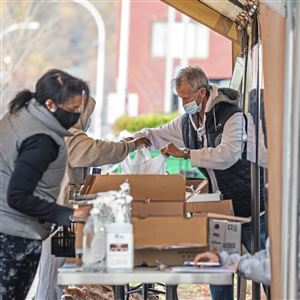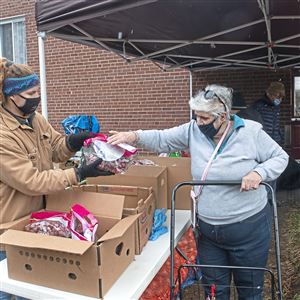When cars line up outside the Greater Pittsburgh Community Food Bank, LaShawn Youngblood walks the long road to greet everyone who drives in — one after another after another.
Some people are crying. Many used to have good-paying jobs and didn’t imagine they’d end up needing a food pantry. Ms. Youngblood tries to make them smile, to give hope, to help them feel “it won’t always be like this.”
“I really want to hug them and say, ‘It’s OK. We’re here,’ said Ms. Youngblood, of Wilmerding, who has volunteered up to 60-or-so hours a month for the Duquesne-based food bank during the pandemic. “We’re helping to at least put food on your table for this week.”
While an outpouring of volunteers, donors and partners has helped the nonprofit fulfill surging demand since COVID-19 surfaced locally in March, food bank President Lisa Scales expects the need will stay elevated for several years — even if vaccines curb the virus in 2021.
Answering that call will take long-term community support as the group tries to help Western Pennsylvanians understand the scope and persistence of hunger and related need in the area, organizers said. The food bank had been serving upward of 110,000 people in 11 counties before the pandemic drove up regional food insecurity by an estimated 42%, largely through unemployment.
Food insecurity generally means having limited or uncertain access to enough healthy and affordable food — a condition that can lead to hunger.
“The pandemic has put a spotlight on disparities and the number of people who are food-insecure,” Ms. Scales said in a conversation leading up to Thanksgiving. “People have been in lines for [food] distributions long before the pandemic spread to southwestern Pennsylvania.”
Need spiked during the recession that took hold in 2008, too, climbing perhaps as much as 20% at one point, she said. The demand for food assistance remained up for at least a year afterward, Ms. Scales recalled.
Still, the recession’s impact was relatively muted in the Pittsburgh area, where modest home prices and stable housing stock somewhat blunted the national downturn, she said. She forecast a more enduring effect in the region from the pandemic.
As of September, unemployment in Pennsylvania was up 3.5 percentage points — at roughly 8.1% — compared with the same period a year earlier. From July through September, the food bank supplied about 18% more food, in pounds, compared to the same period a year ago, it reported.
Identifying precisely how many people received that help is complicated, in large measure because the food bank collaborates with more than 400 partner organizations. But organizers said there’s no mistaking the upward trend in residents seeking a hand.
“We wish we had a crystal ball. We have a sense it’s not going to get better any time soon, although we hope we’re all wrong,” said Bart Huchel, the food bank’s chief financial officer, alluding to the economic stress.
Matching increased demand, the organization has recently booked around $1 million in extra monthly operating costs amid the pandemic, he said. One of the largest food banks in Pennsylvania, it counts on charitable giving — not including donated food — for 55% to 65% of its annual budget.
Bolstered contributions since March have proven more than enough to keep pace with need, at least so far, said Charla Irwin-Buncher, the chief development officer. More than 55,000 donors gave more than 107,000 gifts from mid-March through Oct. 31, up from around 14,900 donors and roughly 31,000 gifts in the year-ago period, she said.
Recent giving has slipped somewhat from earlier months but remains above average for this point in the year, Ms. Irwin-Buncher said. Projections suggest the food bank’s operating costs could climb as high as $27 million for 2020-21, up some 42% from a more typical fiscal year. An audited financial statement is expected next month.
“Generally when there is financial strain in the economy, and the need for human services grows, donors tend to shift their giving” in that direction, she said, noting a 36% increase in contributions during the last recession.
At the same time, Ms. Irwin-Buncher said, people may lose sight of the ongoing need once the news cycle moves on to other stories. The food bank has an opportunity “to stay out there in the community and educate folks about our work,” she said.
She encouraged people to consider taking up a food bank collection at their virtual Thanksgiving celebrations, and to consider monthly charitable contributions that can be set up through pittsburghfoodbank.org.
On the corporate side, regional companies are among those buoying attention. Giant Eagle launched a donation campaign at check-out registers and gas pumps that’s generated some $1.7 million for the food bank since March, company spokeswoman Jannah Jablonowski said.
The supermarket chain is “taking every opportunity we can to be creative and figure how to identify unique ways to support, generate awareness in the community and really keep this at top of mind for the Pittsburgh community,” Ms. Jablonowski said.
As the food bank strategizes distribution logistics, overall reliance on the group will depend in part on federal spending for the Supplemental Nutrition Assistance Program, according to policy experts. Once known as the food-stamp program, SNAP can provide many times more food aid and ease pressure on emergency outfits such as food banks, said Ellen Vollinger, legal director for the nonprofit Food Research & Action Center in Washington, D.C.
“You can do a lot on the food-hardship side if you get those [federal] benefits where they need to be,” Ms. Vollinger said. “Those will have a stimulative effect, which hopefully will help the economy overall.”
Adam Smeltz: asmeltz@post-gazette.com, Twitter @asmeltz
First Published: November 25, 2020, 10:13 a.m.






















